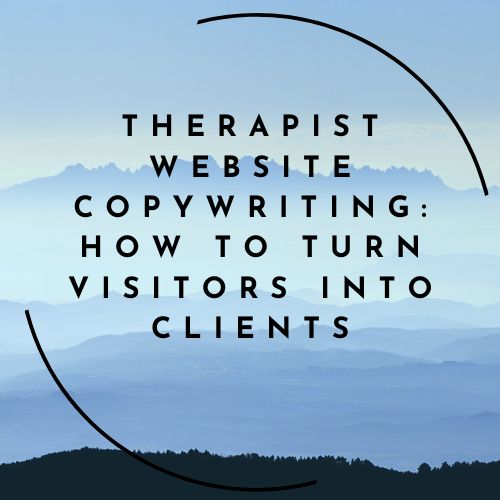Many therapists invest in professional website design—choosing calming colors, clean layouts, and aesthetic images. But even the most beautifully designed website won’t convert visitors into clients if the words don’t connect.
Your website copy—the actual words on your homepage, service pages, and about page—determines whether a potential client feels seen, understood, and ready to take action.
A well-written therapy website should:
✔ Make visitors feel immediately understood and at ease
✔ Clearly communicate who you help and how therapy with you works
✔ Guide visitors toward booking a session or consultation
✔ Avoid jargon, vague language, or overly formal writing
If your website isn’t bringing in consistent inquiries, the issue might not be visibility—it might be the way your content is written. Let’s break down how to write website copy that turns visitors into paying clients.
Learn More About My Writing Services for Therapists
1. Your Homepage: The First Impression That Keeps Visitors Reading
Your homepage is your digital handshake. It’s where potential clients decide within seconds whether they want to learn more—or click away.
What Your Homepage Should Include:
✔ A clear, client-centered opening statement
✔ A brief overview of who you help and how you help them
✔ A strong call to action (CTA) that invites the visitor to take the next step
Best Homepage Example:
✅ “Are you feeling overwhelmed, anxious, or stuck in patterns that no longer serve you? I help adults who are struggling with stress, relationships, and self-doubt find clarity and confidence through supportive, evidence-based therapy.”
This immediately:
✔ Acknowledges the client’s experience
✔ Uses accessible, warm language (not clinical jargon)
✔ Clearly states how therapy can help
Common Homepage Mistake:
❌ “Welcome to my practice. I am a Licensed Clinical Social Worker (LCSW) with a focus on psychodynamic and trauma-informed therapy.”
🚫 This is too therapist-centered—clients need to see themselves in your words.
💡 Call to Action Example:
✅ “Ready to start feeling better? Schedule a free 15-minute consultation today.”
2. Your About Page: Make It Personal, Not Just Professional
The About Page is one of the most visited pages on a therapist’s website because clients want to know who they’ll be working with.
What Your About Page Should Include:
✔ A warm, inviting introduction
✔ A short, client-centered statement about why you do this work
✔ A professional overview of your experience and approach
✔ A personal touch (hobbies, values, something humanizing)
Best About Page Example:
✅ “Therapy should feel like a safe, welcoming space where you can be yourself. I became a therapist because I believe in the power of meaningful connection and the resilience of the human spirit. Whether you’re navigating anxiety, trauma, or big life transitions, my role is to help you feel supported, heard, and empowered.”
This:
✔ Creates an emotional connection
✔ Feels human, not just like a resume
✔ Reassures the reader that therapy will be a supportive process
💡 Personal Touch Example:
✅ “Outside of therapy, I love hiking, reading historical fiction, and spending time with my golden retriever, Max. I believe that joy and self-care are essential parts of the healing journey.”
3. Your Services Page: Speak Your Client’s Language
The Services Page is where potential clients determine:
- If you offer therapy for their specific needs
- If they feel comfortable with your approach
- What their next step should be
How to Structure a Strong Services Page:
1️⃣ Start with a client-centered statement
✅ “If you’re struggling with anxiety, past trauma, or relationship challenges, you don’t have to navigate it alone. Therapy can help you build coping skills, heal from past wounds, and feel more in control of your life.”
2️⃣ Clearly outline your services in a simple way
✔ Individual Therapy
✔ Couples Therapy
✔ EMDR for Trauma
✔ Therapy for Highly Sensitive People
3️⃣ Briefly explain how each service works
✅ “Anxiety Therapy: Through CBT, mindfulness, and somatic techniques, I help clients manage overwhelming thoughts and develop practical coping strategies that bring relief.”
🚫 Common Mistake:
❌ Using long paragraphs filled with technical language like “I integrate an attachment-based, somatic, and existential approach with an emphasis on intersubjectivity.”
💡 Instead, keep it clear, warm, and solution-focused.
4. Calls to Action: Make It Easy for Clients to Reach Out
Your website’s job is to guide visitors toward taking the next step—whether that’s booking a consultation, calling your office, or sending an email.
Strong Call to Action Examples:
✅ “Therapy is an investment in your well-being. If you’re ready to take the next step, let’s connect. Schedule a free 15-minute consultation today.”
✅ “Not sure if therapy is right for you? I’m happy to answer any questions—reach out here.”
🚫 Common Mistake:
❌ Hiding the contact button or making it hard to find
💡 Best Practice:
✔ Have a “Book a Consultation” button on every page
✔ Make sure your contact info is easy to find
Final Thoughts: Your Words Matter as Much as Your Credentials
A beautiful website alone won’t bring in clients—but the right words will. By focusing on client-centered, accessible, and engaging website copy, you can:
✔ Turn visitors into inquiries and paying clients
✔ Build trust before the first session
✔ Create a professional, inviting online presence
Need Help Writing Your Therapy Website?
I specialize in client-centered, SEO-optimized copywriting for therapists, ensuring your website:
✅ Speaks directly to your ideal clients
✅ Feels warm, engaging, and professional
✅ Encourages inquiries and bookings
Learn More About My Writing Services for Therapists

